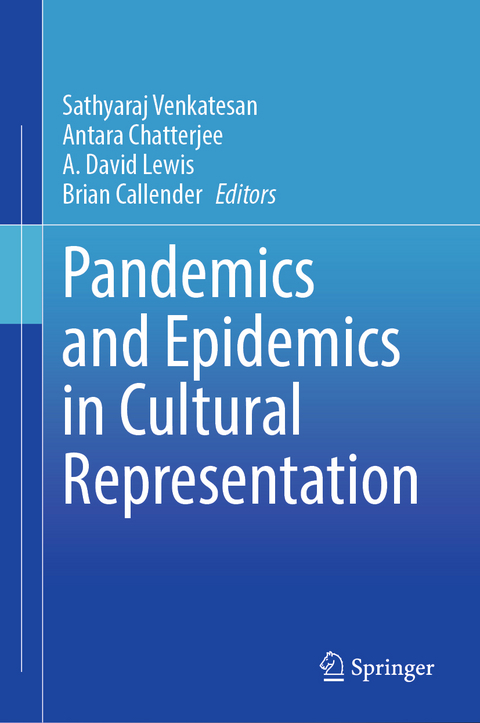
Pandemics and Epidemics in Cultural Representation
Springer Verlag, Singapore
978-981-19-1295-5 (ISBN)
Sathyaraj Venkatesan PhD is an Associate Professor of English in the Department of Humanities and Social Sciences at the National Institute of Technology (NIT), Tiruchirappalli, India. His research concentrates on health humanities, comics studies, and graphic medicine. He is the author of eight books and over ninety-five research publications that span American literature, health humanities, graphic medicine, film studies, and other literary and culture studies disciplines. His recent co-authored books are Metaphors of Mental Illness in Graphic Medicine (Routledge, 2021) and India Retold (Bloomsbury, 2021). Antara Chatterjee PhD is an Assistant Professor of English in the Department of Humanities and Social Sciences at the Indian Institute of Science Education and Research, (IISER), Bhopal, India. Her research interests include Indian writing in English, South Asian diasporic literatures, trauma, violence and cultural memory, medical and environmental humanities. She has received grants and fellowships from the University Grants Commission, India, the Charles Wallace India Trust, the Indian Council of Historical Research, and the Indian Institute of Advanced Study, Shimla, India. She has publications in South Asian Review, Humanities, and in an edited collection of essays The Postcolonial Short Story published by Palgrave Macmillan. She has chapters forthcoming in edited collections to be published by Bloomsbury and Routledge. She is set to be the inaugural Strauss Fellow at the Cedars-Sinai Center for Medicine, Holocaust and Genocide Studies at the Cedars-Sinai Medical Center, LA, USA, in summer 2022. A. David Lewis PhD is the Eisner Award-nominated author of American Comics, Religion, and Literary Theory: The Superhero Afterlife as well as co-editor of both Graven Images: Religion in Comic Books and Graphic Novels and Muslim Superheroes: Comics, Islam, and Representation. Featured on numerous podcast and television programs, Dr. Lewis is currently program director for the MHS degree at the MCPHS University School of Arts & Sciences where his teaching and research focus on graphic medicine, specifically the depiction of cancer in comic books and graphic novels. Finally, he is the acclaimed author of such comics as The Lone and Level Sands and Kismet, Man of Fate. Brian Callender M. D. is an Associate Professor of medicine at the University of Chicago. He is a faculty member of the MacLean Center for Clinical Medical Ethics and co-organized the 2020-2021 lecture series, ethics and the COVID-19 pandemic: Medical, Social, and Political Issues. As a core faculty member of the Institute on the Formation of Knowledge, he teaches health humanities courses, including: The Body in Medicine and the Performing Arts; Graphic Medicine: Concepts and Practice; The Art of Healing: Medical Aesthetics in Russia andthe U.S.; Death Panels: Exploring Dying and Death through Comics; and The Narratives and Aesthetics of Contagion: Knowledge Formation and the COVID-19 Pandemic. He has also curated two exhibits at the University of Chicago’s Special Collections Research Center that examine the visual culture of medicine: Imaging/Imagining: The Body in Anatomical Representation and The Fetus in Utero: From Mystery to Social Media.
Epidemic Narrative: Two Paradigms.- Chaucer’s Canterbury Tales as a Postpandemic Text.- “The Invisible Operator”: Plague, Corruption and Conspiracy in Renaissance Drama.- Three Facets of the Literary Imagination of Cholera: Hysteria, Ridicule, and the Rise of Bacteriology, 1830-1900.- The Blue Death: Cholera and Reimagined Community in Nineteenth-century Havana.- Reading Toronto’s Response to Spanish Influenza: The Globe and Daily Star Report on the 1918-20 Pandemic’s Second Wave.- Outbreak Narratives of the 1918 Influenza Pandemic: Contagion, Community, andPolitics in Myla Goldberg’s Wickett’s Remedy and Thomas Mullen’s The Last Town on Earth.- Spatial Pathologies: The Biopolitics of Disease, Death, and the Caste-body in Ananthamurthy’s Samskara: A Rite for a Dead Man.- “No Country for the Infirm”: Reading Angels in America During COVID-19.- “Bleeding” into Reality: Popular Representations of Ebola and the 2013-2016 EbolaEpidemic.- Wearing Masks: Living and Coping “WITH CORONA” in Japan under the Pandemic.- <3 I AM TRACY: Meme Culture, Coping, and Community during the COVID-19 Pandemic.- Comics, Cartoons, and Vignettes: The Graphic Narratives of the COVID- 19 Pandemic.- “their lives just don’t matter?”: “Racing” COVID-19 and Graphic Medicine.- Caste in Epidemics in India: A Historical and Literary Reading.
| Erscheinungsdatum | 27.05.2022 |
|---|---|
| Zusatzinfo | 14 Illustrations, color; 1 Illustrations, black and white; X, 266 p. 15 illus., 14 illus. in color. |
| Verlagsort | Singapore |
| Sprache | englisch |
| Maße | 155 x 235 mm |
| Themenwelt | Geisteswissenschaften ► Sprach- / Literaturwissenschaft ► Anglistik / Amerikanistik |
| Geisteswissenschaften ► Sprach- / Literaturwissenschaft ► Literaturwissenschaft | |
| Studium ► Querschnittsbereiche ► Prävention / Gesundheitsförderung | |
| Naturwissenschaften ► Biologie | |
| Schlagworte | Covid-19 • Cultural representation of pan/epidemics • Epidemics • Germ Narratives • health humanities • pandemics • Visual culture of medicine |
| ISBN-10 | 981-19-1295-5 / 9811912955 |
| ISBN-13 | 978-981-19-1295-5 / 9789811912955 |
| Zustand | Neuware |
| Informationen gemäß Produktsicherheitsverordnung (GPSR) | |
| Haben Sie eine Frage zum Produkt? |
aus dem Bereich


